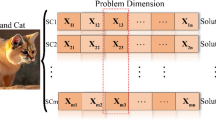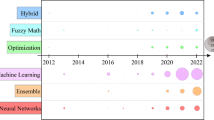Abstract
Strainburst poses significant risks to the safety of workers in deep underground engineering. Assessing strainburst potential plays a crucial role in disaster prevention. Due to the anisotropy and heterogeneity of rock mass, it is essential to quantify the strainburst potential from the perspective of probability. This study aims to propose a methodology that integrates Monte Carlo simulation (MCS) and machine learning (ML) algorithms to evaluate the probability of strainburst potential. First, a numerical model based on damage initiation and spalling limit (DISL) method is established. Then, a novel indicator, absolute local energy release rate (ALERR), is proposed to assess strainburst potential, which describes the absolute value of elastic strain energy released after rock mass failure. The location of the maximum value of ALERR is used to determine the depth of outburst pit, which is adopted to evaluate the strainburst potential level. So, the quantitative relationship between strainburst potential and ALERR can be established. Thereafter, a strainburst dataset including six variables and the depth of outburst pit is obtained based on the MCS method and numerical model. To improve the computational efficiency, seven different ML algorithms are integrated with MCS to calculate the probability of strainburst potential, respectively. Finally, the proposed methodology is used for the strainburst potential evaluation in the 3# headrace tunnel of Jinping II hydropower station. Results show that random forest (RF) and gradient boosting (GB) algorithms have better evaluation performance and can be combined with MCS to calculate the probability of strainburst potential reliably. The proposed methodology can provide valuable guidance for the probability assessment of strainburst potential.
Highlights
-
A new methodology that integrates Monte Carlo simulation (MCS) and machine learning (ML) algorithms is proposed to evaluate the probability of strainburst potential.
-
A novel indicator, absolute local energy release rate (ALERR), is proposed to assess strainburst potential.
-
A numerical model, which combines MCS and damage initiation and spalling limit (DISL) approaches, is established to simultaneously simulate the brittle failure behavior of hard rock and variability of rock mechanics parameters.









Similar content being viewed by others
References
Adoko AC, Gokceoglu C, Wu L, Zuo QJ (2013) Knowledge-based and data-driven fuzzy modeling for rockburst prediction. Int J Rock Mech Min Sci 61:86–95
Aladejare AE, Akeju VO (2020) Design and sensitivity analysis of rock slope using monte carlo simulation. Geotech Geol Eng 38:573–585
Barton N, Lien R, Lunde J (1974) Engineering classification of rock masses for the design of tunnel support. Rock Mech 6(4):189–236
Cai M (2016) Prediction and prevention of rockburst in metal mines-a case study of sanshandao gold mine. J Rock Mech Geotech Eng 8(2):204–211
Cai M, Kaiser PK (2018) Rockburst support reference book: volume 1—Rockburst phenomenon and support characteristics. MIRARCO—Mining Innovation, Laurentian University, Sudbury
Castro LAM, Bewick RP, Carter TG (2012) An overview of numerical modelling applied to deep mining. In: Sousa V, Fernandes A (eds) Innovative numerical modeling in geomechanics. CRC Press, London, pp 393–414
Chen WZ, Lu SP, Guo XH, Qiao CJ (2009) Research on unloading confining pressure tests and rockburst criterion based on energy theory. Chin J Rock Mech Eng 28(8):1530–1540
Cook NGW (1966) The design of underground excavations: in the 8th US symposium on rock mechanics USRMS. Am Rock Mech Assoc 6(4):45–52
Diederichs MS (2003) Rock fracture and collapse under low confinement conditions. Rock Mech Rock Eng 36(5):339–381
Diederichs MS (2007) Mechanistic interpretation and practical application of damage and spalling prediction criteria for deep tunnelling. Can Geotech J 44(9):1082–1116
Diederichs MS, Carter T, Martin CD (2010) Practical rock spall prediction in tunnels. Proceedings of international tunnelling Association world tunnel congress, pp 1–8
Dong LJ, Li XB, Peng K (2013) Prediction of rockburst classification using random forest. T Nonferr Metal Soc 23(2):472–477
Durrheim RJ (2010) Mitigating the risk of rockbursts in the deep hard rock mines of South Africa: 100 years of research. In: Brune J (ed) Extracting the science: a century of mining research. Society for mining, metallurgy and exploration, Littleton, pp 156–171
Edelbro C (2009) Numerical modelling of observed fallouts in hard rock masses using an instantaneous cohesion-softening friction-hardening model. Tunn Undergr Sp Tech 24(4):398–409
Feng XT, Chen BR, Zhang CQ, Li SJ, Wu SY (2013) Mechanism, warning and dynamic control of rockburst development processes. Science Press, Beijing
Feng GL, Feng XT, Chen BR, Xiao YX, Yu Y (2015) A microseismic method for dynamic warning of rockburst development processes in tunnels. Rock Mech Rock Eng 48(5):2061–2076
Gong FQ, Yan JY, Li XB (2018) A new criterion of rock burst proneness based on the linear energy storage law and the residual elastic energy index. Chin J Rock Mech Eng 37(9):1993–2014
Gong FQ, Yan JY, Li XB, Luo S (2019) A peak-strength strain energy storage index for rock burst proneness of rock materials. Int J Rock Mech Min Sci 117:76–89
Guo JQ, Zhao Q, Wang JB, Zhang J (2015) Rockburst prediction based on elastic strain energy. Chin J Rock Mech Eng 34(9):1886–1893
Hajiabdolmajid V, Kaiser PK, Martin CD (2002) Modelling brittle failure of rock. Int J Rock Mech Min Sci 39(6):731–741
Hawkes I (1966) Significance of in-situ stress levels. Proceedings of the 1st International Society for Rock Mechanics and Rock Engineering Congress, Portugal, Lisbon
Heal D, Hudyma M, Potvin Y (2006) Evaluating rockburst damage potential in underground mining. proceedings of the 41st US Symposium on rock mechanics (USRMS), Golden, pp 1020–1025
Hedley DGF (1991) A five-year review of the Canada-Ontario industry rockburst project. Canada centre for mineral and energy technology, Ottawa
Jia QJ, Wu L, Li B, Chen CH, Peng YX (2019) The comprehensive prediction model of rockburst tendency in tunnel based on optimized unascertained measure theory. Geotech Geol Eng 37(4):3399–3411
Kaiser PK, Cai M (2012) Design of rock support system under rockburst condition. J Rock Mech Geotech Eng 4(3):215–227
Keneti A, Sainsbury BA (2018) Review of published rockburst events and their contributing factors. Eng Geol 246:361–373
Kidybiński A (1981) Bursting liability indices of coal. Int J Rock Mech Min Sci 18(4):295–304
Langford JC, Diederichs MS (2015) Reliable support design for excavations in brittle rock using a global response surface method. Rock Mech Rock Eng 48(2):669–689
Li N, Jimenez R (2018) A logistic regression classifier for long-term probabilistic prediction of rock burst hazard. Nat Hazards 90(1):197–215
Liang WZ, Zhao GY, Wu H, Dai B (2019a) Risk assessment of rockburst via an extended MABAC method under fuzzy environment. Tunn Undergr Sp Tech 83:533–544
Liang WZ, Zhao GY, Wang X, Zhao J, Ma CD (2019b) Assessing the rockburst risk for deep shafts via distance-based multi-criteria decision making approaches with hesitant fuzzy information. Eng Geol 260:105211
Martin CD, Kaiser PK, McCreath DR (1999) Hoek-brown parameters for predicting the depth of brittle failure around tunnels. Can Geotech J 36(1):136–151
Mitri HS, Tang B, Simon R (1999) FE modelling of mining-induced energy release and storage rates. J S Afr I Min Metall 99(2):103–110
Pedregosa F, Varoquaux G, Gramfort A, Michel V, Thirion B, Grisel O, Blondel M, Prettenhofer P, Weiss R, Dubourg V, Vanderplas J, Passos A, Cournapeau D, Brucher M, Perrot M, Duchesnay E (2011) Scikit-learn: machine learning in python. J Mach Learn Res 12:2825–2830
Pu YY, Apel DB, Xu HW (2019) Rockburst prediction in kimberlite with unsupervised learning method and support vector classifier. Tunn Undergr Sp Tech 90:12–18
Qiu SL, Feng XT, Zhang CQ, Wu WP (2011) Development and validation of rockburst vulnerability index(RVI) in deep hard rock tunnels. Chin J Rock Mech Eng 30(6):1126–1141
Qiu SL, Feng XT, Jiang Q, Zhang CQ (2014) A novel numerical index for estimating strainburst vulnerability in deep tunnels. Chin J Rock Mech Eng 33(10):2007–2017
Russenes BF (1974) Analysis of rock spalling for tunnels in steep valley sides (MSc Thesis). Norwegian lnstitute of Technology
Simser BP (2019) Rock burst management in Canadian hard rock mines. J Rock Mech Geotech Eng 11(5):1036–1043
Sinha S, Walton G (2018) A progressive s-shaped yield criterion and its application to rock pillar behavior. Int J Rock Mech Min Sci 105:98–109
Stacey TR (1981) A simple extension strain criterion for fracture of brittle rock. Int J Rock Mech Min Sci 18(6):469–474
Su GS, Feng XT, Jiang Q, Chen GQ (2006) Study on new index of local energy release rate for stability analysis and optimal design of underground rock mass engineering with high geostress. Chin J Rock Mech Eng 25(12):2453–2460
Tao ZY (1988) Support design of tunnels subjected to rockbursting. International society for rock mechanics international symposium, Madrid
Turchaninov IA, Markov GA, Gzovsky MV, Kazikayev DM, Frenze UK, Batugin SA, Chabdarova UI (1972) State of stress in the upper part of the Earth’s crust based on direct measurements in mines and on tectonophysical and seismological studies. Phys Earth Planet Inter 6(4):229–234
Wang JL (2013) Mechanical characteristics of deeply buried marble and its technical application (PhD Thesis). Kunming University of Science and Technology
Wang CL, Wu AX, Lu H, Bao TC, Liu XH (2015) Predicting rockburst tendency based on fuzzy matter–element model. Int J Rock Mech Min Sci 75:224–232
Wang XT, Li SC, Xu ZH, Xue YG, Hu J, Li ZQ, Zhang B (2019) An interval fuzzy comprehensive assessment method for rock burst in underground caverns and its engineering application. B Eng Geol Environ 78(7):5161–5176
Wang MW, Liu QY, Wang X, Shen FQ (2020) Prediction of rockburst based on multidimensional connection cloud model and set pair analysis. Int J Geomech 20(1):04019147
Xu XL (2017) Research on the experiment and meso-simulation of tensile characteristics and its fracture mechanism of brittle rock (PhD Thesis). University of Science and Technology Beijing
Xu J, Jiang JD, Xu N, Liu QS, Gao YF (2017) A new energy index for evaluating the tendency of rockburst and its engineering application. Eng Geol 230:46–54
Xue Y, Cao ZZ, Du F, Zhu L (2018) The influence of the backfilling roadway driving sequence on the rockburst risk of a coal pillar based on an energy density criterion. Sustainability 10(8):2609
Xue YG, Bai CH, Kong FM, Qiu DH, Li LP, Su MX, Zhao Y (2020) A two-step comprehensive evaluation model for rockburst prediction based on multiple empirical criteria. Eng Geol 268:105515
Yang FJ, Zhou H, Lu JJ, Zhang CQ, Hu DW (2015) An energy criterion in the process of rockburst. Chin J Rock Mech Eng 34(S1):2706–2714
Zhang CS, Chen XR, Hou J, Chu WJ (2010) Study of mechanical behavior of deep-buried marble at Jinping II hydropower station. Chin J Rock Mech Eng 29(10):1999–2009
Zhang CQ, Zhou H, Feng XT (2011) An index for estimating the stability of brittle surrounding rock mass: FAI and its engineering application. Rock Mech Rock Eng 44(4):401–414
Zhang CQ, Feng XT, Zhou H, Qiu SL, Wu WP (2012) Case histories of four extremely intense rockbursts in deep tunnels. Rock Mech Rock Eng 45(3):275–288
Zhou J, Li XB, Mitri HS (2018) Evaluation method of rockburst: state-of-the-art literature review. Tunn Undergr Sp Tech 81:632–659
Acknowledgements
This work was supported by the National Key Research and Development Program of China (2018YFC0604606), the Natural Science Foundation of China (51904334), and the Natural Science Foundation of Hunan Province, China (2022JJ40601, 2021JJ40751).
Author information
Authors and Affiliations
Corresponding author
Ethics declarations
Conflict of interest
The authors declare no conflict of interest.
Additional information
Publisher's Note
Springer Nature remains neutral with regard to jurisdictional claims in published maps and institutional affiliations.
Rights and permissions
Springer Nature or its licensor holds exclusive rights to this article under a publishing agreement with the author(s) or other rightsholder(s); author self-archiving of the accepted manuscript version of this article is solely governed by the terms of such publishing agreement and applicable law.
About this article
Cite this article
Liang, W., Liu, H., Zhao, G. et al. Assessing the Probability of Strainburst Potential Via an Integration of Monte Carlo Simulation and Machine Learning Algorithms. Rock Mech Rock Eng 56, 129–142 (2023). https://doi.org/10.1007/s00603-022-03067-4
Received:
Accepted:
Published:
Issue Date:
DOI: https://doi.org/10.1007/s00603-022-03067-4




